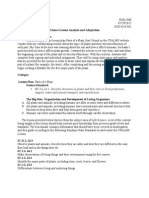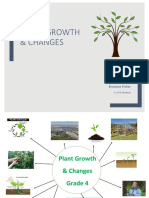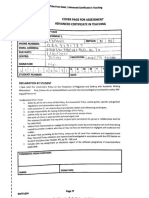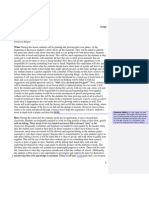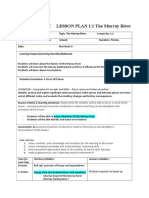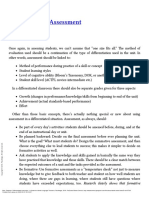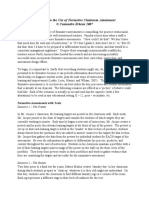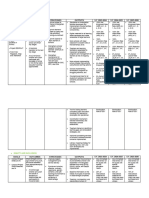Self-Assessment of Workshop
Uploaded by
api-285245808Self-Assessment of Workshop
Uploaded by
api-285245808Carrie Sun The Story of How I Am Learning to Teach (2015)
Self-assessment of my workshop
Date
Information
Feb 3 Worked collaboratively over a long period
of time with 2 other students interested in
teaching about plants and how to make it
more engaging.
Connections (e.g. between what learnt and
how I plan to use it to support student learning)
Extensions (e.g. further questions,
extensions, other applications,
improvements)
I would definitely use this lesson as part of my
activity toolbox for teaching plants. These
activities can also be modified for Grade 12
biology plants as well.
For some reason, I dont think we ever
got back the classess feedback for us
as the facilitators, only the video clips.
I know from watching the videos that
The question we wanted students to focus
on was: What are the distinguishing
characteristics of different plants? It
was broad enough that it could cover
almost every curriculum expectation, but
also interesting enough to do a lot of
different activities that answers that
question. It is also a good starting
question to build on knowledge as the
class goes through the unit, and provides
a lot of collaborative learning
opportunities.
Grouping strategy: Each student gets a
plant related card (fruit, pine needles, pine
cones, flowers, mosses, ferns). We tried
to focus it on the different types of plants
(nonvascular seedless, vascular seedless,
vascular angiosperm, and vascular
gymnosperm). Students must find the
table that has the most relevant
specimens that matches their card (we
tried to use as many real specimens as
possible - e.g. real fruit, pine needles,
etc.)
Started off with a diagnostic, called Plant
BINGO (topic bingo was one of the Peel
For the walkabout, if I was doing it in the
classroom for real, I would have students bring
something for the record of their learning to add
to their notes. The exploration and walkabout
would create their notes (then teacher could do
assessments based on whatever they explored
and wrote down). And we explained this idea to
the students as well.
I might even use the build your own plant
activity as a springboard activity to visit time
and again to build on ideas and explore new
concepts throughout the unit, in the same way
Reebops can do.
It may also be good to complement the Build
Your Own activity with a Grow Your Own Plant
activity throughout the unit (which we obviously
couldnt do during our 1 hour workshop).
I know though that I want to improve the
brainstorm bingo activity. Maybe instead
of me listing off the facts, a student or a
group of students could do it and lead
the class instead.
When I did the Sweller Questions activity
with my grade 10 applied math class (for
measurement and units, using boxes
and cones and other household objects
that had shapes), it didnt go over too
well, even with the incentive of Pokemon
Badge System. Only the students who
typically did stuff, did it, and the students
who typically didnt do stuff, didnt do it.
Which wasnt surprising.
Depending on the context and what
students know, the teacher can build on
the Sweller Questions activity, and
students can do more than just write
down what they see, smell, taste, and
feel. They can use math and physics and
chemistry and any other subjects they
know and incorporate it with that. (e.g.
measure how large different plant seeds
are vs. what they grow up to be) (or
Carrie Sun The Story of How I Am Learning to Teach (2015)
Procedures). Students write down
everything they know about plants in a
5x5 grid, then the facilitator reads out
some precompiled facts and they try to
make a bingo. The winning group got a
prize.
We then went into our Explore First,
Explain Later activity: Sweller
Questions/Challenge each other activity.
At the table, students explore everything
about their specimen and record their
observations and learning, but must
decide on what to put down on the paper
together, by challenging each other. We
did an example using broccoli to show
them. Then students did a walkabout and
explored other groups specimens and see
what they recorded.
Final activity - Also Explore First, Explain
Later style: Build your own plant. We
provided a bunch of craft materials, and
asked students in their groups to build
their plants, now knowing what they know
about the characteristics of plants from
the first 2 activities! Then we had the
groups show how they incorporated
different features in their plant model and
then explain the features.
We also explained how teachers can take
it to the next level for their class - you can
incorporate research elements, or drawing
from other units (e.g. what features must
your plant organisms possess to be
evolutionarily superior to Earth plants?)
learn about the chemistry behind how
plants use their xylem and phloem - like
the coloured celery POE). This may be
easier to do for 7-8 class, than high
school (because continuity-wise).
Carrie Sun The Story of How I Am Learning to Teach (2015)
I liked how Cathy allowed us to give her
feedback on the workshop assessment
feedback form (Feedback on the
feedback!). I like how we changed the
language to something more positive and
constructive, and the final product had
more prompts about what to look for.
Self-Assessment of Workshop Critical Thinking Questions REFLECTION
Critical Thinking Question
Does this activity support my enduring
knowledge criteria (i.e. what I want my
students to remember from my class
long after theyre gone?)
Yes/No
Yes
Is this activity safe?
Is this activity interesting for all
students?
Yes
No
Does this activity allow students to
think critically?
Yes
Can I determine (assess) what
students have learned from this
lesson?
How many expectations was I able to
cluster in this lesson?
Yes
Yes
Why/How?
We want students to understand distinguishing features of different plants and their
importance, and these activities act as a perfect springboard to begin exploring that.
After they leave, students should always remember some of the main parts of a plant and
how it is used.
Besides scissors, there is nothing that could harm a student.
Theres no way something can be interesting to ALL students in a class. There will always
be ones who think its dumb, or who get bored, or dont understand, etc. I think the best
thing to do is just be positive and enthusiastic as possible with this stuff and be a role
model (i.e. make your own model to show the class)
For the Sweller Questions/Challege Each Other activity, students can take it to the next
level by exploring components about their specimen beyond just what they see or feel. The
teacher can perhaps facilitate critical thinking by: They can interact with others and
challenge preconceptions; they can do research on their plant; during the walkabout, they
can find other plants and compare and contrast them, etc.
For the Make Your Plant activity, teacher can perhaps facilitate critical thinking by:
introducing next-level questions (e.g. what features will you include in your plant to make it
evolutionarily superior to Earth plants?), and incorporating that into the activity; students
can be given restraints and must build a plant given the scenario; students must modify
their plant based on a scenario, etc.
One can easily modify these activities to be formatives and/or summatives. The diagnostic
BINGO is already a good formative. For a summative, students could do a project similar to
this, or a summative test could incorporate open-ended questions about the activities (e.g.
Overall:
f2. And f3.
Carrie Sun The Story of How I Am Learning to Teach (2015)
Specific:
f2.1, f2.3, f3.1, f3.2
However, this this is only brief introduction to these topics, obviously you as the teacher
would continue to build on todays activities and go as detailed as the curriculum needs,
and continue to uncover even more expectations.
You might also like
- MID-YEAR REVIEW FORM (MRF) For Master Teacher I-IV80% (15)MID-YEAR REVIEW FORM (MRF) For Master Teacher I-IV7 pages
- Breannafishergrade 4 Plant Growth Changes Unit PlanNo ratings yetBreannafishergrade 4 Plant Growth Changes Unit Plan9 pages
- LP-Classification of Plants Based On Growth HabitNo ratings yetLP-Classification of Plants Based On Growth Habit3 pages
- Common Core Standards:: Plant PresentationNo ratings yetCommon Core Standards:: Plant Presentation6 pages
- Science Lesson Plan Field Experience-1-1No ratings yetScience Lesson Plan Field Experience-1-16 pages
- --How Plants Work- Student Discovery Journal-teachers EditionNo ratings yet--How Plants Work- Student Discovery Journal-teachers Edition26 pages
- The Follow 3 Points Need To Thought About Before You Create Your Lesson PlanNo ratings yetThe Follow 3 Points Need To Thought About Before You Create Your Lesson Plan7 pages
- RPH Tahun 3 (External Features of Plants)No ratings yetRPH Tahun 3 (External Features of Plants)7 pages
- Date Teacher (S) Name: Lesson Plan Type: Grade Level: Subject/Topic: Timeline: Teks ObjectivesNo ratings yetDate Teacher (S) Name: Lesson Plan Type: Grade Level: Subject/Topic: Timeline: Teks Objectives9 pages
- Seton Hill University Lesson Plan Template: Name Subject Grade Level Date/DurationNo ratings yetSeton Hill University Lesson Plan Template: Name Subject Grade Level Date/Duration6 pages
- Lesson Plan Format: It'S Harvest Time! by Jean McelroyNo ratings yetLesson Plan Format: It'S Harvest Time! by Jean Mcelroy3 pages
- Certificate of Qualification and Registration: Penghui Sun, OCTNo ratings yetCertificate of Qualification and Registration: Penghui Sun, OCT1 page
- 2010 Newsletter February 11 - Curated by Penghui SunNo ratings yet2010 Newsletter February 11 - Curated by Penghui Sun6 pages
- Introduction To Diversity of Life Lesson Plan - Day 1No ratings yetIntroduction To Diversity of Life Lesson Plan - Day 15 pages
- Carrie Sun - The Story of How I Am Learning To Teach: Explore First, Explain LaterNo ratings yetCarrie Sun - The Story of How I Am Learning To Teach: Explore First, Explain Later6 pages
- UGC Guidelines For Autonomous Colleges in 11th FYPNo ratings yetUGC Guidelines For Autonomous Colleges in 11th FYP15 pages
- Committed To Excellence in Innovation: Differentiated Assessment ToolNo ratings yetCommitted To Excellence in Innovation: Differentiated Assessment Tool8 pages
- Lesson Plan Introduction To The Murray River and HydrologyNo ratings yetLesson Plan Introduction To The Murray River and Hydrology3 pages
- Principles: The Aim of This Part of The Curriculum Design Process Is To Decide How Learning Can Be EncouragedNo ratings yetPrinciples: The Aim of This Part of The Curriculum Design Process Is To Decide How Learning Can Be Encouraged26 pages
- Roles of Audiologists and Speech-Language Pathologists Working With Persons With Attention Deficit Hyperactivity DisorderNo ratings yetRoles of Audiologists and Speech-Language Pathologists Working With Persons With Attention Deficit Hyperactivity Disorder41 pages
- GRADES 1 To 12 Daily Lesson Log Monday Tuesday Wednesday Thursday FridayNo ratings yetGRADES 1 To 12 Daily Lesson Log Monday Tuesday Wednesday Thursday Friday4 pages
- Internal Assessment Resource Chemistry Level: Standard TitleNo ratings yetInternal Assessment Resource Chemistry Level: Standard Title14 pages
- Module 4: Learning Objectives: Explain How Reliability and Validity Can Influence Interpretation of Research ResultsNo ratings yetModule 4: Learning Objectives: Explain How Reliability and Validity Can Influence Interpretation of Research Results12 pages
- National Competency Based Teacher Standards: Milagros Lim - Borabo, PHD70% (10)National Competency Based Teacher Standards: Milagros Lim - Borabo, PHD118 pages
- Differentiated Instruction A Guide For World Langu... - (5 Differentiated Assessment) PDFNo ratings yetDifferentiated Instruction A Guide For World Langu... - (5 Differentiated Assessment) PDF22 pages
- MID-YEAR REVIEW FORM (MRF) For Master Teacher I-IVMID-YEAR REVIEW FORM (MRF) For Master Teacher I-IV
- Breannafishergrade 4 Plant Growth Changes Unit PlanBreannafishergrade 4 Plant Growth Changes Unit Plan
- --How Plants Work- Student Discovery Journal-teachers Edition--How Plants Work- Student Discovery Journal-teachers Edition
- The Follow 3 Points Need To Thought About Before You Create Your Lesson PlanThe Follow 3 Points Need To Thought About Before You Create Your Lesson Plan
- The Seven T's of Practical Differentiation: Alphabet Sevens, #2From EverandThe Seven T's of Practical Differentiation: Alphabet Sevens, #2
- Date Teacher (S) Name: Lesson Plan Type: Grade Level: Subject/Topic: Timeline: Teks ObjectivesDate Teacher (S) Name: Lesson Plan Type: Grade Level: Subject/Topic: Timeline: Teks Objectives
- Seton Hill University Lesson Plan Template: Name Subject Grade Level Date/DurationSeton Hill University Lesson Plan Template: Name Subject Grade Level Date/Duration
- Lesson Plan Format: It'S Harvest Time! by Jean McelroyLesson Plan Format: It'S Harvest Time! by Jean Mcelroy
- The Seven R's of Great Group Work: Alphabet Sevens, #3From EverandThe Seven R's of Great Group Work: Alphabet Sevens, #3
- Certificate of Qualification and Registration: Penghui Sun, OCTCertificate of Qualification and Registration: Penghui Sun, OCT
- 2010 Newsletter February 11 - Curated by Penghui Sun2010 Newsletter February 11 - Curated by Penghui Sun
- Introduction To Diversity of Life Lesson Plan - Day 1Introduction To Diversity of Life Lesson Plan - Day 1
- Carrie Sun - The Story of How I Am Learning To Teach: Explore First, Explain LaterCarrie Sun - The Story of How I Am Learning To Teach: Explore First, Explain Later
- UGC Guidelines For Autonomous Colleges in 11th FYPUGC Guidelines For Autonomous Colleges in 11th FYP
- Committed To Excellence in Innovation: Differentiated Assessment ToolCommitted To Excellence in Innovation: Differentiated Assessment Tool
- Lesson Plan Introduction To The Murray River and HydrologyLesson Plan Introduction To The Murray River and Hydrology
- Principles: The Aim of This Part of The Curriculum Design Process Is To Decide How Learning Can Be EncouragedPrinciples: The Aim of This Part of The Curriculum Design Process Is To Decide How Learning Can Be Encouraged
- Roles of Audiologists and Speech-Language Pathologists Working With Persons With Attention Deficit Hyperactivity DisorderRoles of Audiologists and Speech-Language Pathologists Working With Persons With Attention Deficit Hyperactivity Disorder
- GRADES 1 To 12 Daily Lesson Log Monday Tuesday Wednesday Thursday FridayGRADES 1 To 12 Daily Lesson Log Monday Tuesday Wednesday Thursday Friday
- Internal Assessment Resource Chemistry Level: Standard TitleInternal Assessment Resource Chemistry Level: Standard Title
- Module 4: Learning Objectives: Explain How Reliability and Validity Can Influence Interpretation of Research ResultsModule 4: Learning Objectives: Explain How Reliability and Validity Can Influence Interpretation of Research Results
- National Competency Based Teacher Standards: Milagros Lim - Borabo, PHDNational Competency Based Teacher Standards: Milagros Lim - Borabo, PHD
- Differentiated Instruction A Guide For World Langu... - (5 Differentiated Assessment) PDFDifferentiated Instruction A Guide For World Langu... - (5 Differentiated Assessment) PDF










